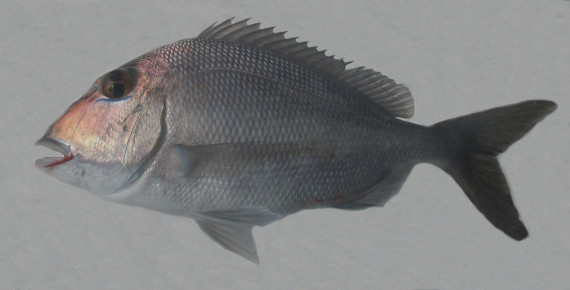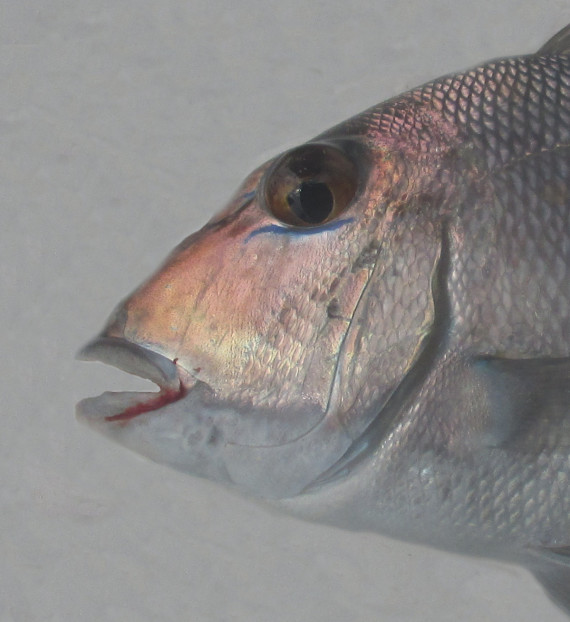Jolthead Porgy, Calamus bajonado
 Jolthead Porgy, Calamus bajonado. Fish caught from coastal waters off Islamorada, Florida, April 2012. Length: 38 cm (15 inches). Catch, photograph and identification courtesy of George Brinkman, Guelph, Ontario, Canada.
Jolthead Porgy, Calamus bajonado. Fish caught from coastal waters off Islamorada, Florida, April 2012. Length: 38 cm (15 inches). Catch, photograph and identification courtesy of George Brinkman, Guelph, Ontario, Canada.
 Jolthead Porgy, Calamus bajonado. Fish caught from coastal waters off Ft. Lauderdale, Florida, July 2021. Length: 40 cm (16 inches). Catch, photograph and identification courtesy of Luke Ovgard, Klamath Falls, Oregon.
Jolthead Porgy, Calamus bajonado. Fish caught from coastal waters off Ft. Lauderdale, Florida, July 2021. Length: 40 cm (16 inches). Catch, photograph and identification courtesy of Luke Ovgard, Klamath Falls, Oregon.

 Jolthead Porgy, Calamus bajonado. Fish caught from the Florida Middle Grounds within the Gulf of Mexico, March 2016. Length: 41 cm (16 inches). Catch, photographs and identification courtesy of George Brinkman, Guelph, Ontario, Canada.
Jolthead Porgy, Calamus bajonado. Fish caught from the Florida Middle Grounds within the Gulf of Mexico, March 2016. Length: 41 cm (16 inches). Catch, photographs and identification courtesy of George Brinkman, Guelph, Ontario, Canada.
The Jolthead Porgy, Calamus bajonado, is a member of the Porgy or Sparidae Family, and is known in Mexico as pluma. Their common name is derived from their feeding behavior as they “jolt” mollusks from rocks. Globally, there are thirteen species in the genus Calamus, of which nine are found in Mexican waters, eight in the Atlantic and one in the Pacific Ocean.
The Jolthead Porgy is characterized by their “porgy-like” laterally compressed relatively deep body, which have a depth that is 41 to 44% of standard length. They are perhaps the drabbest colored Porgy. They have an overall silvery to brassy coloration with a bluish cast. The front of their head is brown with a blue line along the lower rim of their eyes, a whitish stripe below their eyes, and another between their eyes and mouth. The corner of their mouth is orange. Juveniles have dark bars on their body and caudal fin. Their head is deep with a long sloping profile that is at a 38o to 42o angle (a key to identification) and a large mouth with thick heavy lips. They are equipped with canine teeth and 2 rows of slender conical teeth at the front of each jaw and with small molariform teeth on the sides of each jaw. Their anal fin has 3 spines and 10 or 11 rays; their caudal fin is forked; their dorsal fin has 12 or 13 spines and 12 rays; and their pectoral fins are long and reach past the anal fin origin. Their body is covered with scales.
The Jolthead Porgies are a common coastal species and are abundant throughout most of their range; they are found in seagrasses, over sandy bottoms, and within coral reefs at depths up to 200 m (655 feet). They reach a maximum length of 76 cm (2 feet 6 inches), but normally range from 35 cm (14 inches) to 50 cm (20 inches) and can weigh up to 10.6 kg (23.lbs 6 oz). As of January 1, 2024, the International Game Fish Association world record stood at 10.45 kg (23 lbs 4 oz) with the fish caught in coastal waters off Madeira Beach, Florida in March 1990. They are normally solitary but can occasionally be found in schools near reefs. They are bottom dwellers that feed primarily on invertebrates including crabs, mollusks, and sea urchins.
The Jolthead Porgy is a resident of all Mexican waters of the Atlantic Ocean including the Gulf of Mexico and the Caribbean.
The Jolthead Porgy is very similar in shape to a series of Porgies and is most likely confused with the Knobbed Porgy, Calamus nodosus (steep head profile), the Littlehead Porgy, Calamus proridens (blue rectangle behind eyes), the Pluma Porgy, Calamus pennatula (blue rectangle behind eyes), the Saucereye Porgy, Calamus calamus (steep 51o to 55o head profile), and the Whitebone Porgy, Calamus leucosteus (blue lines above and below eyes).
From a conservation perspective the Jolthead Porgy is currently considered to be of Least Concern with stable, widely distributed populations. They are considered to be an excellent food fish and are targeted by both commercial and recreational fishermen utilizing hook and line, longlines, bottom trawls and fish traps. They are known to contain ciguatoxin. They are unregulated in most parts of their range (except for coastal waters of the southeast United States) and commercial landings have declined significantly in the last ten years and are currently on the order of ten tons per year. They are subject to habitat destruction and overfishing in some parts of their range.